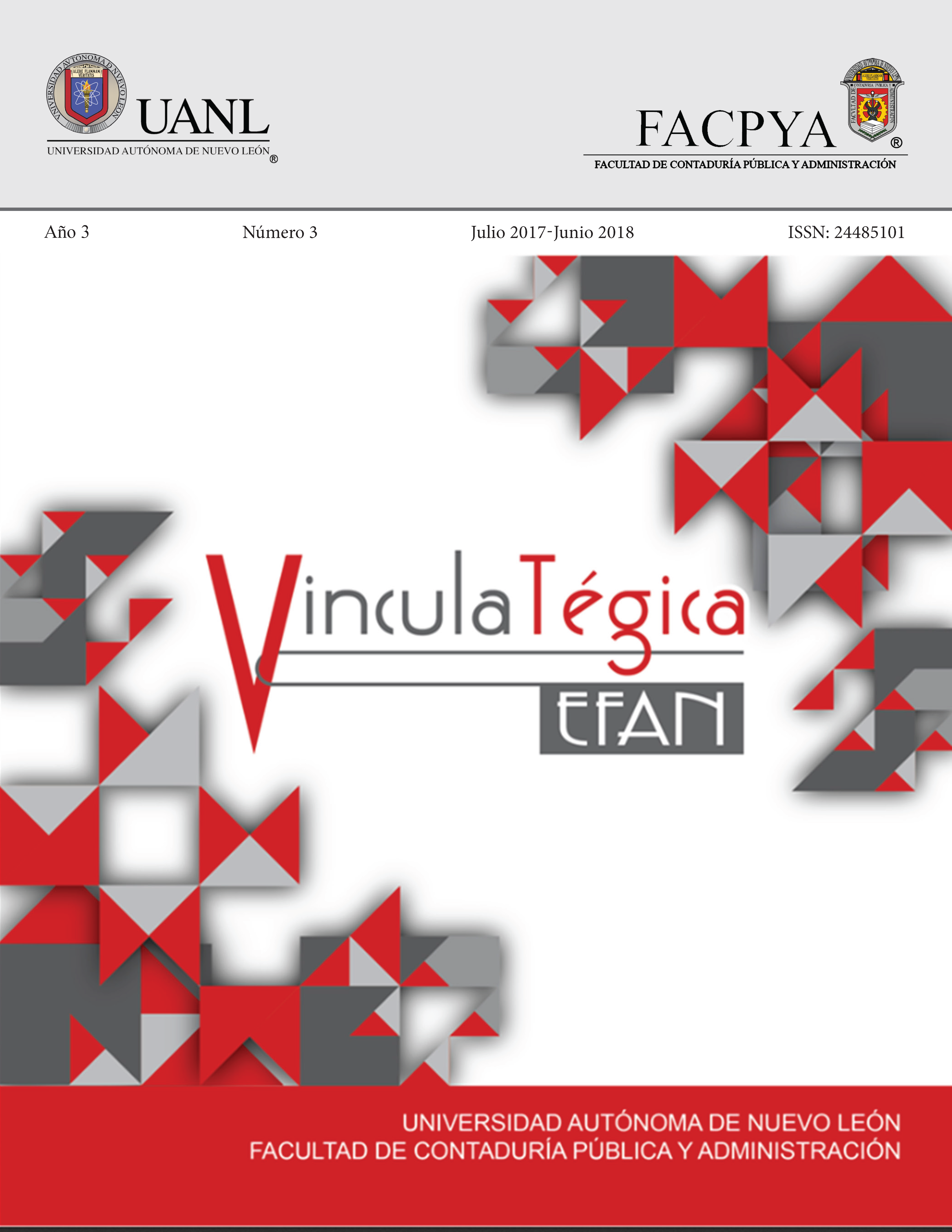Co-Working Spaces in Mexico: A New Business Model in the Sharing Economy
DOI:
https://doi.org/10.29105/vtga3.3-1116Keywords:
Co-Working Spaces, Sharing Economy, Business ModelsAbstract
Co-working spaces are an increasing phenomenon in most cities, with different formats, in some cases individuals look for a place to work on their computer for a few hours, while others assemble specific talent such as freelancers, entrepreneurs, students to socialize, foster collaboration between various disciplines to build a knowledge sharing community, and to create an environment to foster an ecosystem for innovation. This paper will contribute to the understanding of the motivations for joining new working landscapes, specific community-based enterprises as a co-working space, and the synergies of resources, talent and knowledge interacting to foster creativity and innovation.
Downloads
References
Amin, A. and Cohendet, P. (2004). Architectures of knowledge: Firms, capabilities, and communities, Oxford: Oxford University Press. DOI: https://doi.org/10.1093/acprof:oso/9780199253326.001.0001
Bourdieu, P. (2004). Structures and Habitus. Material Culture: Critical Concepts in the Social Sciences, 1(part 1).
Cappelli, P., and Keller, J. R. (2013). Classifying work in the new economy. Academy of Management Review, 38(4), 575-596. DOI: https://doi.org/10.5465/amr.2011.0302
Deskmag Co-Working Spaces. (2016). Retrieved on June 16, 2016 from http://www.deskmag.com/en/coworking-spaces.
Decarolis, D., and Deeds, D. (1999). The impact of stocks and flows of organizational knowledge on firm performance. Strategic management Journal, 20, 953-968. DOI: https://doi.org/10.1002/(SICI)1097-0266(199910)20:10<953::AID-SMJ59>3.0.CO;2-3
Eisenhardt, K.M. and Graebner, M.E. (2007). Theory Building from Cases: Opportunities and Challenges. Academy of Management Journal, 50(1), 25–32. 665 DOI: https://doi.org/10.5465/amj.2007.24160888
Eisenhardt, K.M. and Schoonhoven, C.B. (1996). Resource-based View of Strategic Alliance Formation: Strategic and Social Effects in Entrepreneurial Firms. Organization Science, 7(2), 136–150. DOI: https://doi.org/10.1287/orsc.7.2.136
Feldman, M. S., and Orlikowski, W. J. (2011). Theorizing practice and practicing theory. Organization science, 22(5), 1240-1253. DOI: https://doi.org/10.1287/orsc.1100.0612
Gandini, Alessandro. (2015). The rise of coworking spaces: A literature review. Ephemera, 15(1), 193-205
Gulati, R. and Singh, H. (1998). The Architecture of Cooperation: Managing Costs and Coordination Concerns Appropriation in Strategic Alliances. Administrative Science Quarterly, 43(4), 781–814. DOI: https://doi.org/10.2307/2393616
Kale, P., Singh, H. and Perlmutter, H. (2000). Learning and protection of proprietary assets in strategic alliances: building relational capital. Strategic Management Journal, 21(3), 217–237. DOI: https://doi.org/10.1002/(SICI)1097-0266(200003)21:3<217::AID-SMJ95>3.3.CO;2-P
Klein, B., Crawford, R.G. and Alchian, A.A. (1978). Vertical integration, appropriable rents, and the competitive contracting process. Journal of Law and Economics, 21, 297–326. DOI: https://doi.org/10.1086/466922
von Krogh, G. and Geilinger, N. (2014). Knowledge creation in the eco-system: Research imperatives. European Management Journal, 32(1), 155–163. DOI: https://doi.org/10.1016/j.emj.2013.04.002
Lin, Y., and Wu, L. Y. (2014). Exploring the role of dynamic capabilities in firm performance under the resource-based view framework. Journal of Business Research, 67(3), 407-413. DOI: https://doi.org/10.1016/j.jbusres.2012.12.019
Marshall, M. N. (1996). Sampling for qualitative research. Family Practice, 13(6), 522-526. DOI: https://doi.org/10.1093/fampra/13.6.522
McRobbie, A. (2016). Be creative: Making a living in the new culture industries. John Wiley & Sons.
Mintzberg, H. (2009). Rebuilding companies as communities. Harvard Business Review, 87(7), 1–5.
Nicolini, D. (2009). Zooming in and out: Studying practices by switching theoretical lenses and trailing connections. Organization Studies, 30(12), 1391-1418. DOI: https://doi.org/10.1177/0170840609349875
Peck, J. (2012). Recreative City: Amsterdam, Vehicular Ideas and the Adaptive Spaces of Creativity Policy. International Journal of Urban and Regional Research, 36(3), 462–485. DOI: https://doi.org/10.1111/j.1468-2427.2011.01071.x
Peredo, A.M. and Chrisman, J.J. (2006). Toward a theory of community-based enterprise. Academy of Management Review, 31(2), 309–328. DOI: https://doi.org/10.5465/amr.2006.20208683
Spinuzzi, C. (2012). Working Alone Together: Co-working as Emergent Collaborative Activity. Journal of Business and Technical Communication, 25(4), 399-441 DOI: https://doi.org/10.1177/1050651912444070
Ropo, A., Salovaara, P., Sauer, E., and De Paoli, D. (2015). Leadership in spaces and places. Edward Elgar Publishing. DOI: https://doi.org/10.4337/9781783477920
Ulrich, D. and Barnay, B. (1984). Perspectives in Organizations. Resource Dependency, Efficiency and Population. The Academy of Management Review, 9(3), 471-481. DOI: https://doi.org/10.5465/amr.1984.4279680
Vanderstraeten, J. and Matthyssens, P. (2012) Service-based differentiation strategies for business incubators: Exploring external and internal alignment. Technovation, 32(1), 656-670. DOI: https://doi.org/10.1016/j.technovation.2012.09.002
Williamson, O., and Ghani, T. (2012). Transaction cost economics and its uses in marketing. Journal of the Academy of Marketing Science, 40(1), 74-85. DOI: https://doi.org/10.1007/s11747-011-0268-z
Yin, R. K. (2013). Case study research: Design and methods. Sage Publications.
Downloads
Published
How to Cite
Issue
Section
License

This work is licensed under a Creative Commons Attribution 4.0 International License.
a). Authors keep copyright and give the journal the right of the first publication of the work under a Creative Commons attribution license. This license allows others to share the work as long as original authorship and initial publication in this journal is acknowledged.
b). Authors may make other independent and additional contractual agreements for the non-exclusive distribution of the version of the article published in this journal (e.g., include it in an institutional repository or publish it in a book) as long as they clearly indicate that the work was published for the first time in this journal.







